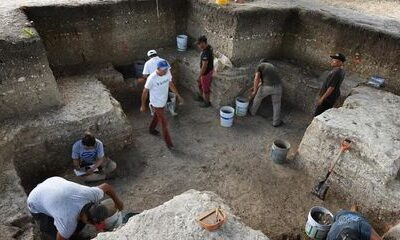Science
Discovery of Ancient Maya Monument Challenges Historical Beliefs

Recent archaeological discoveries in the Maya region have significantly altered the understanding of early Mesoamerican civilizations. Notably, the discovery of a monumental site known as Aguada Fénix in Tabasco, Mexico, challenges the long-held belief that sophisticated societies required strong hierarchical structures to organize large-scale construction projects.
For many years, experts viewed early Maya life as simple and decentralized, with pottery-making communities scattered across the region between 1000 and 700 BCE. It was assumed that large urban centers emerged much later. However, findings at sites such as Ceibal, Cival, and Yaxnohcah began to shift this narrative. The unveiling of Aguada Fénix, a massive platform nearly one mile long and dating back to over 3,000 years ago, marked a pivotal moment in this reassessment.
The significance of Aguada Fénix lies not only in its size but also in its purpose. A recent study led by an international team from the University of Arizona published in the journal Science Advances posits that the site functioned as a cosmic map, or cosmogram, rather than merely a grand platform. This perspective suggests that Aguada Fénix was likely one of the most spiritually significant locations in the ancient Maya world.
The discovery in 2020 revealed a monumental structure that has since been recognized as the largest known monument in the Maya civilization. Following this, nearly 500 smaller sites resembling Aguada Fénix were found across southeastern Mexico, indicating a widespread cultural phenomenon.
During excavations at Aguada Fénix, archaeologists uncovered a cruciform pit filled with ceremonial treasures, including jade axes and intricate carvings of animals and figures. Takeshi Inomata, a Regents Professor of anthropology, remarked, “That told us that this was really an important ritual place.” These artifacts provide invaluable insights into the sacred rituals of the early Maya, suggesting a rich cultural and spiritual life.
Radiocarbon dating of the pit indicates that these rituals occurred between 900 and 845 BCE. Researchers believe that the early Maya builders used colored pigments and sacred items as offerings, which were carefully buried beneath layers of sand and soil. The pit’s contents included colored soils—blue, green, and yellow—arranged to align with the four cardinal directions, a practice significant in Mesoamerican cultures.
Inomata emphasizes that these findings challenge the traditional view of Mesoamerican culture development. He stated, “The study is further evidence opposing the long-held belief that Mesoamerican cultures grew gradually.” Aguada Fénix predates other prominent cities like Tikal and Teotihuacan by nearly a thousand years, rivaling their grandeur.
The site’s construction aligns with the celestial calendar, as the center line of Aguada Fénix points to the sunrise on October 17 and February 24, dates that are 130 days apart and correspond to half of the ancient 260-day sacred calendar. This precise alignment suggests that the builders integrated their understanding of the cosmos into the very fabric of the site.
In addition to its monumental structures, researchers revealed extensive raised causeways, sunken corridors, and water canals extending up to 6 miles (9.7 km), designed to enhance movement and ritual within the landscape. Unlike other significant sites where power was centralized, Aguada Fénix shows no evidence of a ruling elite. Instead, Inomata suggests that its leaders were likely thinkers and planners who shaped the monument based on cosmic principles rather than political power.
These findings carry important implications for contemporary society. Inomata expressed the belief that large achievements do not necessarily require centralized authority or social inequality. “But once you see the actual data from the past, it was not like that. So, we don’t need really big social inequality to achieve important things,” he noted.
Aguada Fénix serves as a testament to what communities can accomplish collaboratively. The site, with its impressive scale, exemplifies the potential of shared purpose, even in a region previously thought to have few monumental constructions.
In the context of Olmec sculptures that often celebrated rulers and deities, the art at Aguada Fénix reflects everyday life, with carvings depicting animals and human figures. This shift in focus suggests that the monumental architecture was not merely an elite vision but a product of communal effort.
Co-author Xanti S. Ceballos Pesina expressed her astonishment at the scale of Aguada Fénix and the fact that it had eluded researchers for so long. “I think it’s very cool that new technologies are helping to discover these new types of architectural arrangements,” she stated. “And when you see it on the map, it’s very impressive that in the Middle Preclassic Period, people with no centralized organization or power were coming together to perform rituals and to build this massive construction.”
The revelations surrounding Aguada Fénix continue to reshape the understanding of ancient Maya civilization, encouraging a reevaluation of how societies can organize and thrive without rigid hierarchies.
-

 Technology5 months ago
Technology5 months agoDiscover the Top 10 Calorie Counting Apps of 2025
-

 Health3 months ago
Health3 months agoBella Hadid Shares Health Update After Treatment for Lyme Disease
-

 Health3 months ago
Health3 months agoErin Bates Shares Recovery Update Following Sepsis Complications
-

 Technology4 months ago
Technology4 months agoDiscover How to Reverse Image Search Using ChatGPT Effortlessly
-

 Technology1 month ago
Technology1 month agoDiscover 2025’s Top GPUs for Exceptional 4K Gaming Performance
-

 Technology3 months ago
Technology3 months agoElectric Moto Influencer Surronster Arrested in Tijuana
-

 Technology5 months ago
Technology5 months agoMeta Initiates $60B AI Data Center Expansion, Starting in Ohio
-

 Technology5 months ago
Technology5 months agoRecovering a Suspended TikTok Account: A Step-by-Step Guide
-

 Health4 months ago
Health4 months agoTested: Rab Firewall Mountain Jacket Survives Harsh Conditions
-

 Lifestyle5 months ago
Lifestyle5 months agoBelton Family Reunites After Daughter Survives Hill Country Floods
-

 Technology4 months ago
Technology4 months agoHarmonic Launches AI Chatbot App to Transform Mathematical Reasoning
-

 Health3 months ago
Health3 months agoAnalysts Project Stronger Growth for Apple’s iPhone 17 Lineup



















